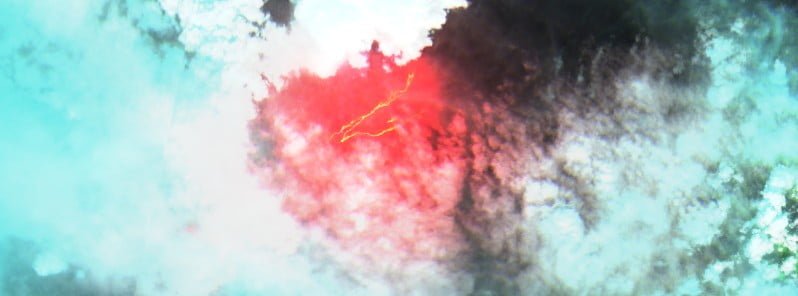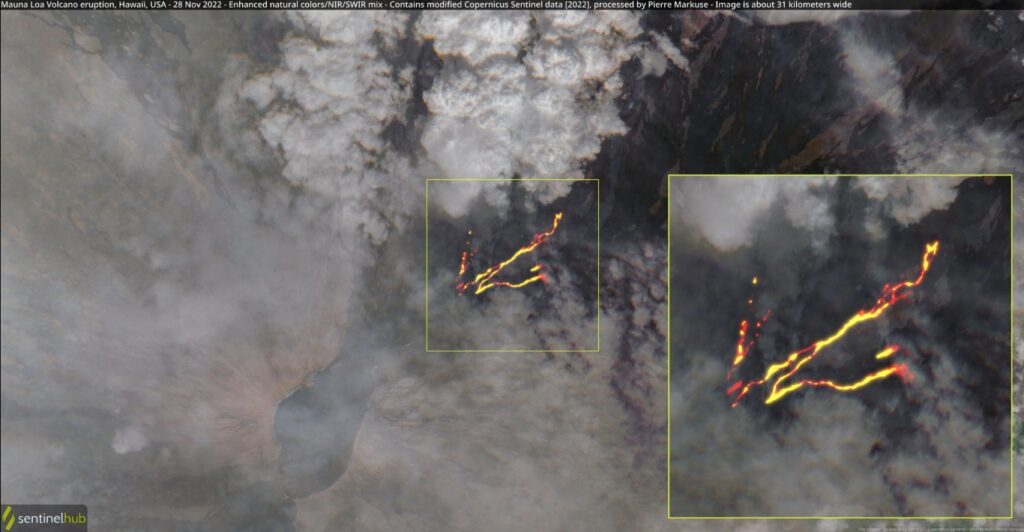Sentinel-2 satellite views erupting Mauna Loa volcano, Hawai’i

Mauna Loa started erupting at around 09:30 UTC on November 28, 2022 (23:30 LT on November 27) in Moku‘āweoweo, the summit caldera of Mauna Loa, inside Hawai‘i Volcanoes National Park. Mauna Loa is the largest active volcano on our planet. Its last eruption took place in 1984 (VEI 0).
By 17:00 UTC, the eruption has migrated from the summit to the Northeast Rift Zone where fissures are feeding several lava flows.
Three fissures erupted as of 23:30 UTC on November 28, but only the lowest of the three fissures was active.
Estimates of the tallest fountain heights are between 30 and 60 m (100 – 200 feet), but most are a few meters tall, HVO volcanologists said.1
The fissures sent lava flows to the northeast and parallel to the rift zone. Lava flows from the two higher fissures moved downslope but stalled about 18 km (11 miles) from Saddle Road.
“We do not expect upper fissures to reactivate,” USGS volcanologists said at 02:55 UTC on November 29.
“However, additional fissures could open along the Northeast Rift Zone below the current location, and lava flows can continue to travel downslope.
“There is no active lava within Moku’āweoweo caldera, and there is no lava erupting from the Southwest Rift Zone. We do not expect any eruptive activity outside the Northeast Rift Zone. No property is at risk currently. There is a visible gas plume from the erupting fissure fountains and lava flows, with the plume primarily being blown to the Northwest.”

For more information about this eruption, visit:
Geological summary
Massive Mauna Loa shield volcano rises almost 9 km (5.6 miles) above the sea floor to form the world’s largest active volcano.
Flank eruptions are predominately from the lengthy NE and SW rift zones, and the summit is cut by the Mokuaweoweo caldera, which sits within an older and larger 6 x 8 km (3.7 x 5 miles) caldera.
Two of the youngest large debris avalanches documented in Hawaii traveled nearly 100 km from Mauna Loa; the second of the Alika avalanches was emplaced about 105 000 years ago (Moore et al. 1989).
Almost 90% of the surface of the basaltic shield volcano is covered by lavas less than 4 000 years old (Lockwood and Lipman, 1987).
During a 750-year eruptive period beginning about 1500 years ago, a series of voluminous overflows from a summit lava lake covered about one-fourth of the volcano’s surface.
The ensuing 750-year period, from shortly after the formation of the Mokuaweoweo caldera until the present, saw an additional quarter of the volcano covered with lava flows predominately from the summit and NW rift zone vents.
This volcano is located within the Hawaiian Islands, a UNESCO World Heritage property.2
References:
1 Eruption begins at Mauna Loa volcano after 38 years of quiescence – Aviation Color Code raised to Red, Hawai’i – The Watchers – November 28, 2022
2 Mauna Loa – Geological summary – GVP
Featured image credit: Copernicus EU/Sentinel-2, Pierre Markuse

Commenting rules and guidelines
We value the thoughts and opinions of our readers and welcome healthy discussions on our website. In order to maintain a respectful and positive community, we ask that all commenters follow these rules.